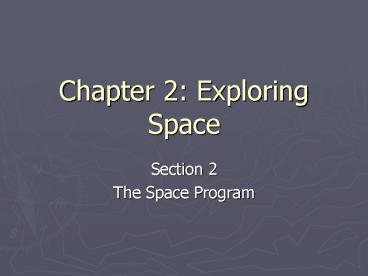Chapter 2: Exploring Space - PowerPoint PPT Presentation
1 / 15
Title:
Chapter 2: Exploring Space
Description:
... the surface, he said, 'That's one small step for man, one giant leap for mankind. ... that the moon may have a small core of molten rock at its center. ... – PowerPoint PPT presentation
Number of Views:155
Avg rating:3.0/5.0
Title: Chapter 2: Exploring Space
1
Chapter 2 Exploring Space
- Section 2
- The Space Program
2
- In 1969 the first human set foot on the moon.
This competition, though, was not between
friends, but between the two most powerful
nations in the world, the United States and the
Soviet Union. Their rivalry in the exploration
of space was called the space race.
3
The Race for Space
- Began in the 1950s and the Soviet Union was the
greatest rival to the United States in politics
and military power. - The tensions between the two countries were so
high that they were said to be in a cold war. - The space race began in 1957 when the Soviets
launched the satellite Sputnik I into orbit.
4
- The United States responded by speeding up its
own space program. - The First Artificial Satellites
- A satellite is an object that revolves around
another object in space. - The moon is a natural satellite of Earth.
- Sputnik I was the first artificial satellite.
- The United States responded in early 1958 by
launching its own satellite, Explorer 1, into
orbit.
5
- Humans in Space
- In 1961, the space race heated up when the
Soviets launched the first human into space. - Yuri Gagarin, a cosmonaut, flew one orbit around
the Earth aboard Vostok 1.
6
- Humans in Space
- Less than a month later, Alan Shepard, an
astronaut, became the first American in space. - The Freedom 7 was part of the U.S. Mercury space
program.
7
- Humans in Space
- The first American to orbit Earth was John Glenn,
who was launched into space in 1962 aboard
Friendship 7. - The tiny capsule orbited Earth three times before
returning to the surface.
8
Missions to the Moon
- I believe that this nation should commit itself
to achieving the goal, before the decade is out,
of landing a man on the moon and returning him
safely to Earth. President John F. Kennedy - The American effort to land astronauts on the
moon was names the Apollo program.
9
- Exploring the Moon
- Between 1964 and 1972, the United States and the
Soviet Union sent many unpiloted spacecraft to
explore the moon. - When a U.S. spacecraft called Surveyor landed on
the moon, it didnt sink into the surface. - This proved that the moon had a solid surface
then humans could land on it.
10
- The Moon Landings
- In July 1969, three American astronauts circled
the moon aboard Apollo 11. - Once in orbit, Neil Armstrong and Buzz Aldrin
entered a tiny spacecraft called Eagle. - On July 20, the Eagle descended toward a flat
area on the moons surface called the Sea of
Tranquility. - When Armstrong first set foot on the surface, he
said, Thats one small step for man, one giant
leap for mankind.
11
(No Transcript)
12
- On the Moons Surface
- Armstrong and Aldrin explored the moon for over
two hours collecting samples to take back to
Earth. - They also planted an American flag.
- Over the next three years, five more Apollo
missions landed on the moon. - Astronauts were able to stay on the moon for days
instead of hours.
13
- Moon Rocks and Moonquakes
- The astronauts collected nearly 400 kilograms of
lunar samples, commonly called moon rocks. - The minerals that make up moon rocks are the same
minerals that are found on Earth. - However, some moon rock minerals combine to form
kinds of rocks that are not found on Earth.
14
- Moon Rocks and Moonquakes
- One way that astronauts explored the structure of
the moon was to purposely crash equipment onto
the moons surface. - Instruments were able to measure the moonquake
waves that resulted. - Scientists determined that the moon may have a
small core of molten rock at its center.
15
- New Missions to the Moon
- The Apollo missions were extremely expensive and
NASA moved on to other projects and the moon was
ignored for decades. - In 2003, the European Space Agency launched an
unpiloted spacecraft to orbit the moon. - Its main purpose was to collect data for a
detailed map of the moon. - Privately funded
- In 2004, the United States announced a plan to
establish a permanent colony of people on the
moon. - The moon would serve as a base so missions could
be launched to carry people to Mars.

